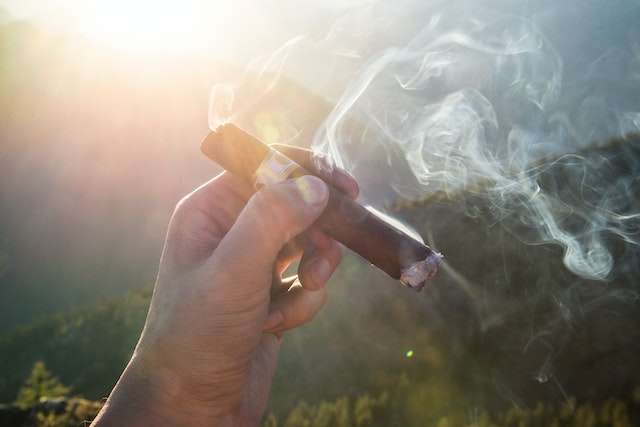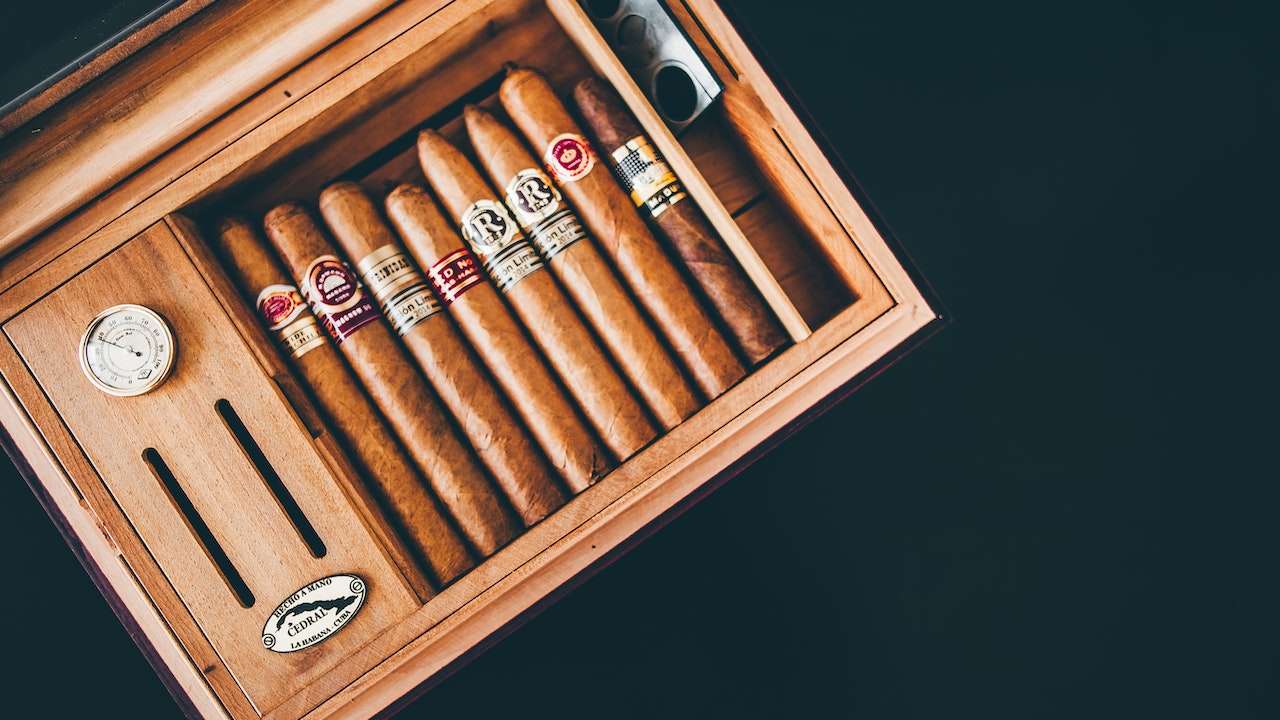To cut a cigar, you will need a sharp cigar cutter. There are different types of cigar cutters available, including guillotine cutters, punch cutters, and V-cutters. Here’s a general guide on how to cut a cigar using a guillotine cutter:
- Gather your supplies: You will need a cigar cutter, a cigar, and a clean surface to work on.
- Inspect the cigar: Before cutting the cigar, inspect it for any defects or imperfections. Make sure the cigar is properly humidified and in good condition.
- Identify the cap: The cap is the sealed end of the cigar that you will cut. Look for a small circular piece of tobacco that covers the head of the cigar.
- Determine the desired cut: Decide how much of the cap you want to remove. The general rule is to cut just enough to create an adequate opening without removing too much.
- Position the cutter: Hold the cigar firmly near the head, between your thumb and forefinger. Place the cigar cutter about 1/8 to 1/16 of an inch above the shoulder of the cap. Make sure the cutter’s opening is wide enough to accommodate the diameter of your cigar.
- Make the cut: With a swift and decisive motion, squeeze the cutter to cut through the cap. Be careful not to crush or damage the cigar. A clean, quick cut is preferable.
- Inspect the cut: After making the cut, examine the cigar’s foot (open end) to ensure that the cap has been cleanly removed. If necessary, you can gently remove any loose tobacco bits.
- Light and enjoy: Now that your cigar is properly cut, you can proceed to light it. Use a quality cigar lighter or match to ignite the foot of the cigar, and enjoy the flavors and aromas as you smoke it.
Remember, different cigars may require different cutting techniques or tools, so it’s a good idea to familiarize yourself with the specific cigar you’re smoking and adjust your cutting method accordingly.
Popular Cigar Accessories
Cigar enthusiasts often invest in various accessories to enhance their smoking experience and properly maintain their cigars. Here are some popular cigar accessories:
- Cigar Cutter: A cigar cutter is used to make a clean and precise cut on the cigar’s closed end before smoking. There are different types available, including guillotine cutters, punch cutters, and V-cutters.
- Cigar Lighter: A high-quality cigar lighter is essential for lighting a cigar properly. Torch lighters, butane lighters, and cedar spill matches are commonly used to provide an even and consistent flame.
- Cigar Ashtray: A dedicated cigar ashtray is designed to accommodate the larger size and longer ash of cigars. They often have deep grooves or holders to rest the cigar, preventing it from rolling off and minimizing the risk of accidental damage.
- Cigar Humidor: A humidor is a controlled environment designed to store and age cigars properly. It helps maintain a stable humidity level, typically between 65% and 75%, which is crucial for preserving the flavors and freshness of cigars.
- Cigar Travel Case: For those who enjoy cigars on the go, a travel case provides a safe and secure way to transport cigars. These cases are usually airtight, crushproof, and equipped with a humidification device.
- Cigar Stand: Cigar stands are handy for keeping your cigar elevated and secure while resting. They come in various designs, including single-cigar stands, multiple-cigar stands, and portable pocket-sized stands.
- Cigar Ashtray with Built-in Cutter: Some ashtrays feature a built-in cutter, combining the functionality of a cutter and an ashtray into a single accessory. These can be convenient for enjoying cigars outdoors or while traveling.
- Cigar Pipe: A cigar pipe is a specialized device that allows you to smoke a cigar while capturing the flavor through the bowl of the pipe. It provides a unique smoking experience that combines elements of both cigars and pipes.
- Cigar Holder: Cigar holders are designed to hold the cigar between puffs, preventing it from going out or needing to relight it frequently. They come in various styles, including clips, rests, and portable holders.
- Cigar Tool Set: A comprehensive cigar tool set often includes multiple accessories like a cutter, lighter, punch, and other tools necessary for preparing and enjoying cigars. These sets are popular among cigar enthusiasts.
Remember that the use of cigar accessories should always be in accordance with local regulations and the preferences of individual smokers.

Story Of Cigars Through History
Cigars, known for their captivating aromas and luxurious allure, have a fascinating history that spans centuries. From their origins in the Americas to becoming a symbol of sophistication and relaxation worldwide, cigars have left an indelible mark on culture, commerce, and social customs. Join us on a journey through time as we explore the captivating history of cigars and the role they have played throughout the ages.
Ancient Origins: The story of cigars begins in the ancient Americas, where tobacco plants grew abundantly. Native peoples, such as the Mayans and the Aztecs, cultivated and used tobacco for religious ceremonies, medicinal purposes, and as offerings to the gods. They would roll tobacco leaves and bind them with strips of plant material, creating the earliest form of what we now recognize as cigars.

European Encounter: The arrival of Christopher Columbus in the Americas in 1492 marked the first European encounter with tobacco. Columbus and his crew were introduced to tobacco by the indigenous people they encountered, and they observed the practice of smoking rolled tobacco leaves. Fascinated by this newfound substance, Columbus and his crew brought tobacco back to Europe, sparking a trend that would quickly spread throughout the continent.
Rise in Popularity: In the following years, tobacco gained popularity among European nobility and elites. It became a status symbol and was associated with wealth and luxury. As demand increased, cigar production expanded, with regions like Cuba and the Caribbean becoming prominent suppliers of high-quality tobacco leaves.
Cuba: The Epitome of Cigar Excellence: Cuba’s fertile soils and favorable climate made it an ideal location for tobacco cultivation. By the 19th century, Cuban cigars had gained a reputation for their exceptional quality and flavor. The emergence of the cigar industry in Cuba brought prosperity to the island, and Havana became renowned as the cigar capital of the world.

The Industrial Revolution and Mass Production: The advent of the Industrial Revolution in the 19th century revolutionized cigar production. Mechanized processes, such as the invention of the cigar-making machine, allowed for faster and more efficient production. This advancement made cigars more accessible to a wider range of consumers, and the cigar industry experienced a boom during this period.
Cigars and Culture: Throughout history, cigars have been intertwined with various cultures and social customs. In the 19th and early 20th centuries, smoking cigars became a symbol of masculinity and power, with prominent figures like Winston Churchill and Sigmund Freud often seen with cigars in hand. Cigar smoking also became a cherished ritual in social gatherings, business meetings, and celebrations.
Shifts in Perception and Regulation: In the 20th century, attitudes toward smoking began to change due to health concerns and increasing awareness of the harmful effects of tobacco. As a result, smoking regulations and anti-tobacco campaigns were introduced in many countries. Despite these changes, the allure of cigars persisted, and they continued to be enjoyed by connoisseurs and enthusiasts worldwide.
The Modern Cigar Renaissance: In recent years, there has been a resurgence of interest in cigars, particularly in the premium and artisanal sectors. Cigar enthusiasts appreciate the craftsmanship, complexity, and artistry that goes into creating a fine cigar. The rise of boutique cigar brands and the growing popularity of cigar lounges and events are evidence of this renaissance.
Conclusion: From ancient rituals to modern-day indulgence, the history of cigars is a testament to the enduring allure and appreciation of this timeless pleasure. As we reflect on the rich tapestry of the cigar’s journey through time, it becomes clear that cigars have transcended mere smoke and become cultural icons, evoking a sense of refinement, camaraderie, and relaxation. As we savor the aroma and flavors of a well-crafted cigar, we honor the traditions and legacies that have shaped its remarkable history.


0 Comments